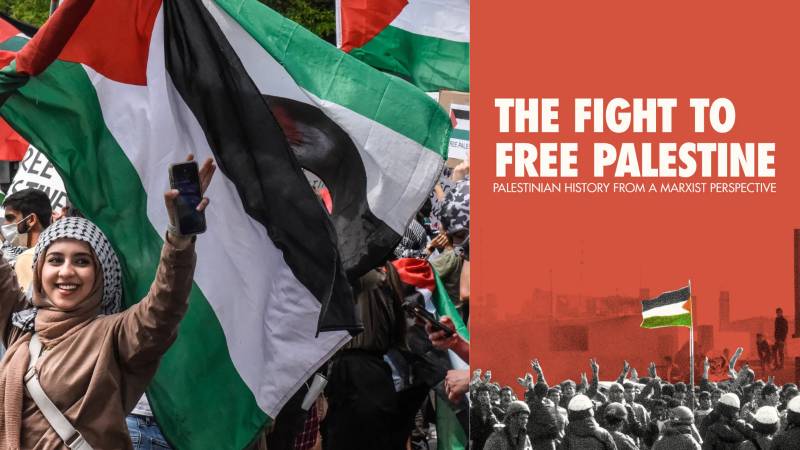
Recently, I bought a short 96-page book from a couple of young students who lead a student communist group on campus. I was intrigued by them, as one wore a free Palestine wristband or something to that effect. Running a communist student group is not exactly praiseworthy in a climate where communists attract disdain from right-wing populists under Trump in the U.S. and Modi in India. Additionally, many students pursue careers through business studies, which is why the passion of these young folks reminds me of the poet-philosopher Muhammad Iqbal (d. 1938):
The youth who reach for the stars - Are the ones I admire indeed.
The book edited by Marco La Grotta is based on articles by Francesco Merli, Fred Weston, Josh Holroyd, and Khaled Malachi that were originally published at marxist.com. It offers Palestinian history from a Marxist perspective. The main argument is that neither a two-state (ala Noam Chomsky) nor a one-state (ala Edward Said and Ilan Pappe) are effective solutions.
Neither a One-State nor a Two-State Solution
The issue is that the façade of a two-state solution with the Oslo Accords has led to the status quo where the Palestinian Authority (PA) betrayed the Palestinian struggle in exchange for becoming a “useful puppet regime for the Israeli state” (p. 70). Josh Holroyd, a young activist and writer, calls it a “rotten peace” (p. 69). His imagery reminds me of the poet of the masses, Habib Jalib (d. 1993):
I refuse to accept a system that brings the morning without light.
Khaled Malachi, another young activist and author, calls out the “comfortable petit-bourgeois lifestyles” of the PA officials that abandoned “solving the refugee crisis” in exchange for the PA “policing the ghettoised cities in the West Bank” and “the open-air prison that is the Gaza Strip” (p. 76).
This reminds one of the deals when natives sold Manhattan for beads and trinkets. While this story has been problematised, the point is that exchange with asymmetrical power can never be free and that the powerful can enjoy a free lunch.
Malachi critiques the two-state solution by highlighting that the Israeli ruling class would not allow a sovereign state with a standing army or an economic competitor on its borders (p. 78). Similarly, he questions the one-state solution by emphasising that Zionist ideology projects Israel as the promised land for the Jews alone and that such a state would constitute apartheid (pp. 80-81).
The Marxist Solution
Both Holroyd and Malachi evoke the slogan “Intifada until Victory” (pp. 73, 85). Malachi argues that “as long as Israel remains an aggressive imperialist state, it will continue to negotiate in bad faith” (p. 82). However, before weaponising charges of “anti-Semitism”, it should be noted that Malachi also argues that “hypocritical Arab regimes – have all contributed to the oppression of the Palestinians” (p. 76).
Through the article by Francesco Merli, the book illustrates instances when Arab regimes mercilessly crushed the Palestinians. This includes the use of “phosphorus and napalm shells” and the massacre of Palestinian civilians under Jordan’s King Hussein (pp. 52-53) and another massacre under Syria’s elder Assad in cahoots with the Lebanese Phalangists (p. 56). Additionally, Merli states that the rich Gulf states have exploited Palestinians to “work in conditions of semi-slavery” without “trade union rights, let alone citizenship rights” (p. 48).
The strength of the book lies in tackling an issue that many dare not tread out of fear of inviting trumped up allegations that rest on weaponised victimhood
Thus, the solution offered by the book is to replace both the Israeli state and the despotic Arab regimes with the “federal socialist state of Israel-Palestine, as part of a Socialist Federation of the Middle East” (pp. 82, 95). The editor of the book, Marco La Grotta, echoes that “there is no solution to Palestinian oppression outside of an international socialist revolution” (p. 3). This is a utopian solution, but Malachi argues that “realistic politics” has already led to a “practical blind alley” (p. 96).
The Need for Systemic Thinking
One does not have to agree with the book in its entirety but there are various points raised in the book that are worth reflecting upon. For instance, while terrorism is associated with Hamas, Merli showcases that the Zionist paramilitary groups Haganah, Irgun, and Lehi “unleashed a campaign of terror” with “coordinated attacks on Palestinian villages” (p. 24).
Such terrorism included “special night squads” and the slaughter of “men, women, and children” to force the Palestinians to flee, and then raze their homes to the ground” (pp. 20, 25). These instances of the past are echoed in the present, as Israel has continued bulldozing homes, usurping resources, and imprisoning Palestinian men, women, and children. This indicates that apart from militant groups, systemic state-sponsored terrorism also needs to be called out.
However, the problem is that many are unable to think with a systems approach and therefore sideline the urgency of addressing a system based on occupation and apartheid. As Malachi contrasts, whilst the international community cries “crocodile tears when the Israeli Defense Forces (IDF) gun down a child throwing sticks and stones”, it goes “rather quiet when it comes to the systematic brutalisation of the Palestinian people” (p. 74).
The Zionist Ideology
Merli takes us to the founding fathers of Zionism through their own words. For instance, about the “expulsion of the Palestinians”, Theodor Herzl is quoted as saying “We must expropriate gently” and that “the removal of the poor must be carried out discreetly and circumspectly” (p. 10). Similarly, Vladimir Jabotinsky argued that the “Palestinians had to be forced into submission with an “iron wall of Jewish bayonets” (p. 12).
David Ben Gurion is quoted as saying that the “Arabs were fighting against dispossession” (p. 18). Likewise, Chaim Weizmann is reported as saying that “if half a million Arabs could be transferred, two million Jews could be put in their place” (p. 29). Thus, the Zionist slogan “a land without a people for a people without a land” removes from the picture “the inconvenient presence of the Palestinians” (p. 21).
Merli further states that “all the main Zionist leaders had been involved in massacres and large-scale terrorism” and that there were “no differences between the Zionist left and the right” (p. 25). This includes Yitzhak Rabin who is attributed with saying to “break the arms and legs” of those caught throwing stones (most of whom were children)” (p. 61).
Whilst Rabin may have rejected saying that, such callous targeting of children continues unabated, as evident from Hindutvist supporters of Israel. For instance, an Indian media personality vociferously stated in 2023 that “If Israel had one thousand children martyred then one million of their children (Palestinians) should die”.
Strange Bedfellows - The Islamist Ideology
Non-binary thinking implies that a critique of capitalism does not mean acceptance of communism and vice versa. Similarly, whilst critiquing Zionism, the book also subjects Hamas to critique.
Merli states that Israel played a role in nurturing Hamas by allowing Sheikh Ahmed Yassin’s group, Mujama Al-Islamiya, to register as a charity to accumulate money and estates (p. 63). Additionally, the “relationship between Mujama and Israel’s secret services was maintained” (p. 64).
The Israeli goal here was to undermine Palestinian resistance with the use of Islamic fundamentalists (p. 64). This tactic is like that used by the Pakistani establishment when it uses Islamist groups to keep political leaders in check.
Malachi argues that the “Zionist ruling class could not have been delivered a better gift than Hamas draping the struggle of the Palestinians in the language of religious fundamentalism” (p. 86). This is because for “every rocket launched”, the Israeli ruling class can perpetuate “a siege mentality” and “whip up a nationalist frenzy” to “distract from problems brewing at home” (pp. 86, 87).
Finally, whilst Merli equates the Israeli left and right, Malachi equates Hamas and Fatah, arguing that their difference “relates to form and not content”, as both have been “brokering clever deals within the parameters set out by the Israeli state” (p. 87).
Overall Assessment
The book hits a snag when it offers a socialist solution but also highlights that the “Zionist trade union confederation Histadrut in Israel plays a shameful role” (p. 92). This suggests that solidarity based on the working class may not cut through nationalist interests.
After all, the rise of right-wing populism known as Trumpism in the U.S. has been driven by workers disenfranchised by hyper-globalisation. Thus, I would argue that socialist solutions may not be feasible until the working class becomes conscious of the “divide and rule” tactics of imperialism and resists their own racism and xenophobia.
However, the strength of the book lies in tackling an issue that many dare not tread out of fear of inviting trumped up allegations that rest on weaponised victimhood. Additionally, it facilitates both systems analysis and non-binary thinking.
Such courageous thinking should not be put down especially by those who go to school to just focus on grades and mindlessly become part of the corporate system. Overall, it is an admirable work by young thinkers who challenge us to think outside the box.

